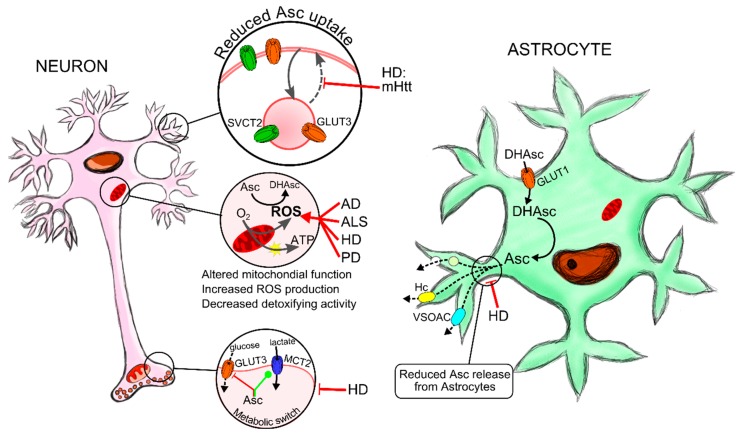Figure 2.
Failure in ascorbic acid homeostasis contributes to neurodegeneration. Neuronal TCA (tricarboxylic acid) and oxidative phosphorylation are highly efficient mechanisms in sustaining synaptic activity. However, the continued use of oxygen generates reactive oxygen species (ROS), which leads to oxidative stress. Therefore, neuronal metabolism and synaptic signalling induce ROS production. Neurons are highly sensitive to oxidative stress and thus ascorbic acid recycling by astrocytes and neuronal uptake through SVCT2 transporters are important mechanisms in maintaining antioxidant defence. During aging as well as in neurodegenerative diseases there is an imbalance in ROS production, decreased levels of antioxidant molecules and impairment in detoxifying enzyme activity such as superoxide dismutase (SOD) or catalase. In HD, accumulation of mutant Huntingtin protein alters mitochondrial biogenesis and expression of antioxidant defence genes, increasing oxidative damage leading to neuronal death. Amyloid β peptide and α-synuclein accumulation in AD and PD respectively, induce ROS production which in turn participates in protein aggregation and neuronal death in both pathologies. SOD1 loss of function due to its mutation is responsible for elevated ROS and causal for a type of ALS. Ascorbic acid levels tend to be reduced in AD, ALS, HD and PD. In HD, we have demonstrated that the failure in astrocytic ascorbic acid release and a decreased neuronal uptake, due to the reduced trafficking of SVCT2 and GLUT3 transporters to the cell surface, are responsible for the impaired metabolic switch, the decreased neuronal antioxidant protection and most likely HD metabolic failure and neuronal death. AD-Alzheimer’s Disease; ALS-Amyotrophic lateral sclerosis; Huntington’s disease-HD; Parkinson’s Disease-PD; mHtt-mutant huntingtin; mSOD-mutant superoxide dismutase; SOD-Superoxide dismutase; ROS-reactive oxygen species.

